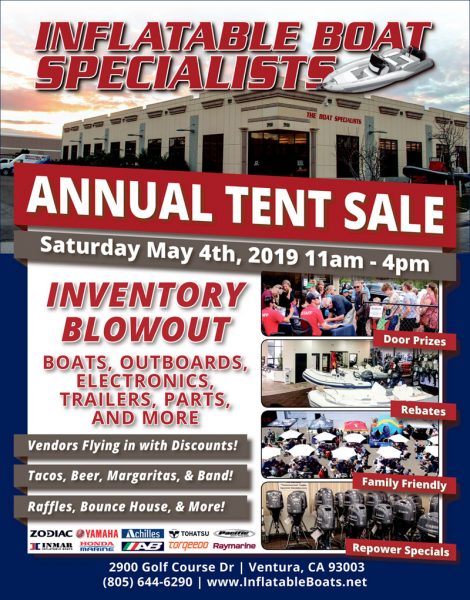
Boats in Oakland Estuary Crushed in Cleanup Operation
Dust, shards of fiberglass and broken dreams filled the air over the Oakland Estuary on Wednesday, as roughly 10 sailboats — most of them designated as abandoned, derelict and illegally anchored — were destroyed. Some vessels were seized by Oakland and Alameda Police Departments, who share jurisdiction of the Estuary, while a few vessels were voluntarily surrendered.
The cleanup — which is partially funded by a grant from the state of California — is part of a Bay Area-wide program to remove “marine debris,” or vessels that are considered unsafe, a danger to navigation, or hazards to marine life and the environment. Underlying the issue of seized boats are, in many cases, homelessness, drug abuse, and the increasing pressures of a housing crisis — not to mention an aging fleet of plastic classics.
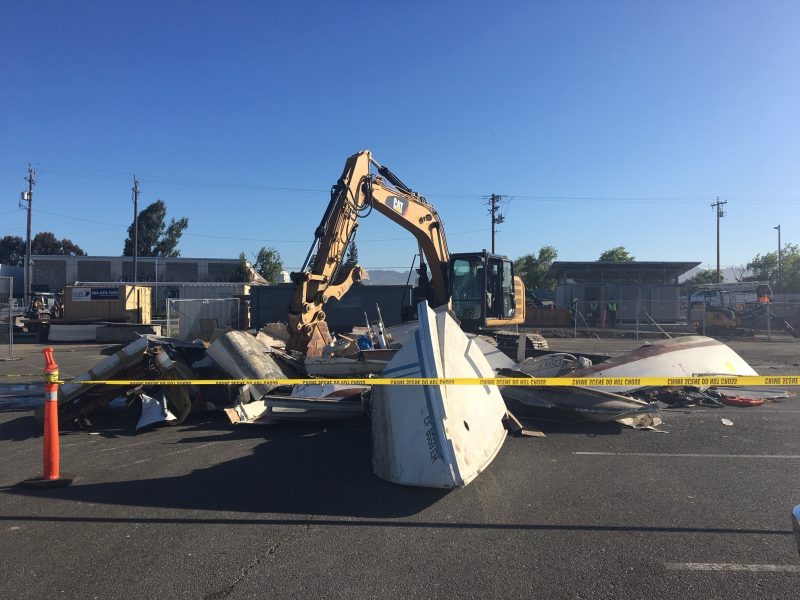
According to reporting from SFGate, Oakland and Alameda PD, “insist[ed] that owners were given months of warning that the boats would be removed,” as is standard practice when identifying marine debris for removal. Boats were seized from public and marina docks, as well as from anchorages in the Estuary.
Oakland Harbormaster Brock de Lappe said there are “no legal anchorages anywhere on the Estuary. If you’re anchored-out, you’re breaking the law. Some of those boats had been there for months.”
Video from KTVU showed several boats being crushed by a backhoe at the boat launch ramp and the adjacent parking lot at the Jack London Aquatic Center on the Oakland Embarcadero, a sight that sent shivers through some of our readers who commented on our Facebook Page.
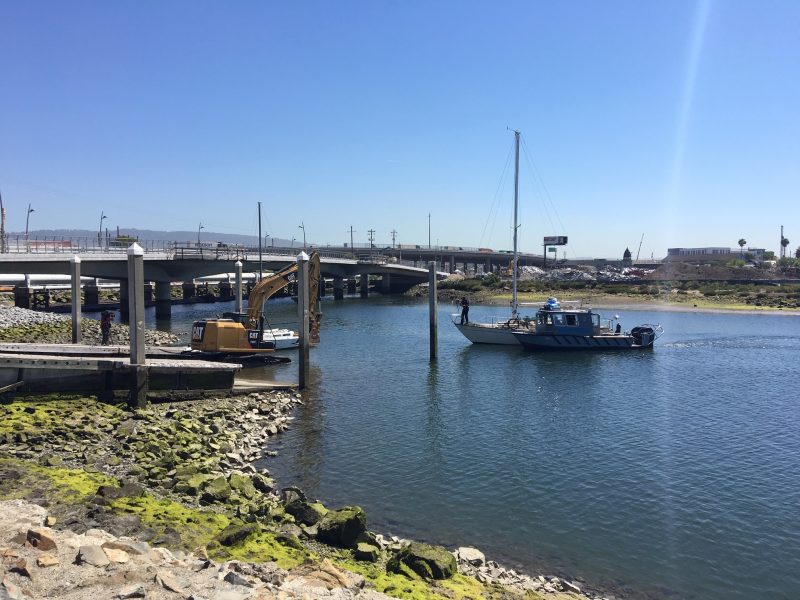
“I don’t like seeing boats crushed. There’s no joy in that for me,” said de Lappe, who was part of the Oakland Estuary Cleanup in 2013 when he was the harbormaster in Alameda. “I have a vested interest in seeing the Estuary be what it should be.”
Many of our readers wondered why the boats that were crushed — one of which was a totally-decent looking Santana 22 — couldn’t be sold or donated. “The paper trail to get a boat like that and pass it on to someone else is virtually impossible,” de Lappe said. “Who was the last legal registered owner of that boat, and how do you track that person down?” In addition, “There are a lot of boats from the ’60s and ’70 that are reaching the end of life, and the blue-collar generation from the ’60s and ’70s are also aging out,” de Lappe said. “And they’re not being replaced by the younger generation, because they don’t have the discretionary funds for boating.”
In the past, de Lappe said that Bay Area harbormasters would obtain abandoned vessels through lien sales, then resell them for a song to people willing to remove the boats from their marinas. But this well-intentioned practice led to the swelling of the Bay Area’s anchor-out population, especially in Richardson Bay, where liveaboards had, until recently, been tolerated.
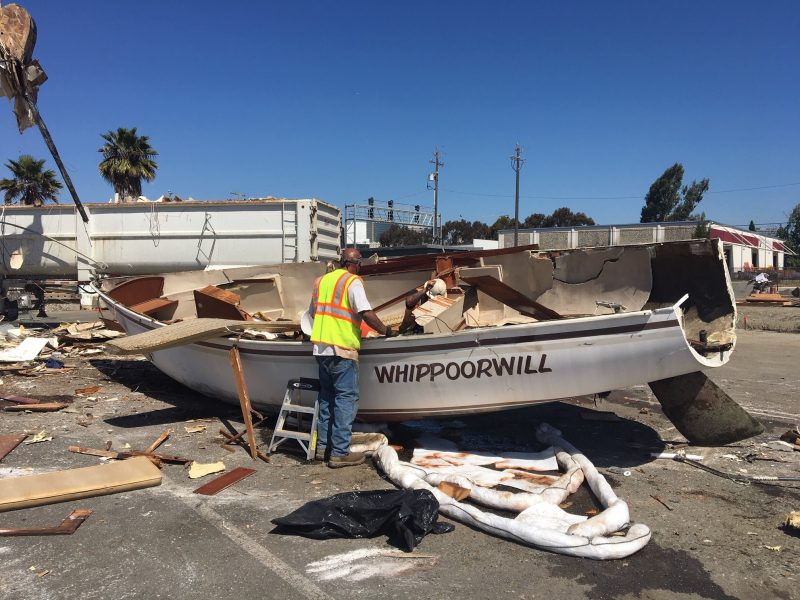
We’ve spoken with a number of Bay Area harbormasters who say they get dozens of calls a day from people looking to live aboard a boat as an affordable housing alternative. For people with even fewer means living on the fringes, old boats have become a last resort, and in many cases, this population becomes a danger to themselves and others on the water. Union Point Park, located on the Oakland side of the Estuary, is currently locked in a legal battle over a homeless encampment there.
And there’s a darker side, still.
“A lot of time when we search these abandoned boats, we find remnants of narcotics [and] stolen property,” Oakland Police officer Kaleo Albino told KTVU. “We have found multiple boats in the past being used as what you would call a meth lab.”
De Lappe said that he wants the Estuary to be a true Gold Coast on the Oakland Embarcadero. “I don’t want to see it be a crime-ridden place — that’s not my idea of a safe Estuary. It’s a gorgeous spot.”
We will have more on the Oakland Estuary in the coming weeks.
Peruvian Tall Ship Sails in the Gate
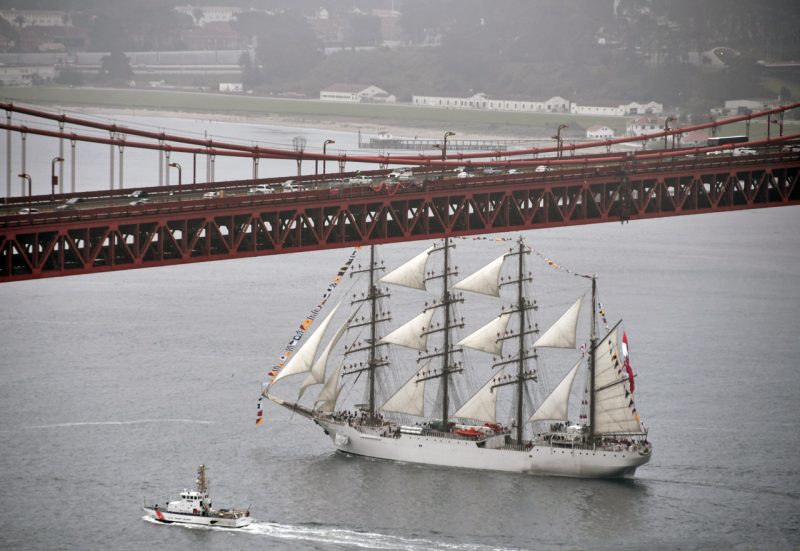
A hardy crew of sailors were onboard Call of the Sea’s Schooner Seaward this morning to welcome the BAP Union as she sailed through San Francisco’s famous Golden Gate. As the Union entered the Bay and sailed gracefully beneath the Golden Gate Bridge, we considered ourselves to be among the fortunate few who witnessed this once-in-a lifetime spectacle. (According to Wikipedia, ‘BAP’ stands for Buque Armada Peruana, which translates to English as Peruvian Navy Ship.)
The Union is a 378-ft LOA four-masted barque with a hull stretching to just over 324 feet. From the deck of Seaward’s 83 feet, we were awed by the sheer size of the vessel and the skill of the 257 sailors who adorned the yardarms and decks to present themselves as our guests.
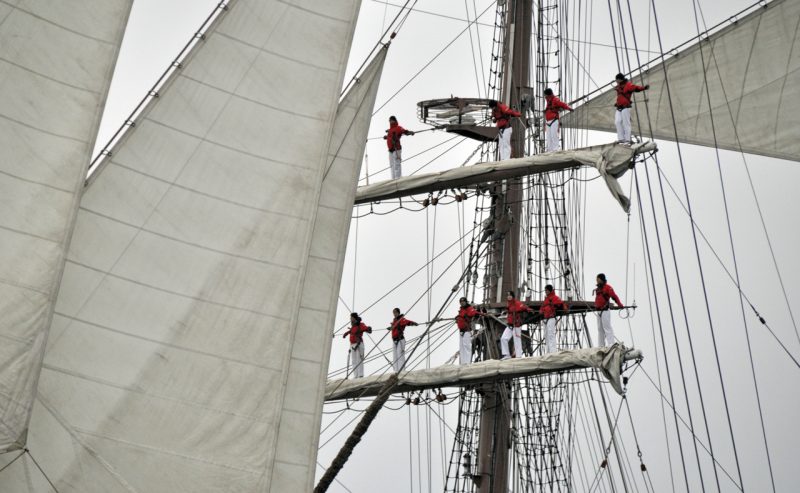
Call of the Sea CEO Steven Woodside says the Union’s visit to the Bay Area is a great boost for sailing and tall ships in particular. “From the very first moment of seeing the Union emerge from the clouds I was excited.” Woodside says he sees this as a great opportunity to promote and encourage sailing and education, particularly for young people. “It’s going to grab young people. It’s going to inspire them to learn more about the waters on which they’re living.”
Deborah Novachick, founding member of Tall Ships Welcome SF Project, feels the BAP Union’s visit represents an opportunity for young people to not only experience shipboard life, but to also learn more about the world in which they live. “I see her as a sailing university. A beautiful, beautiful sailing university teaching a new generation of young people how to participate in the world in a peaceful and respectful way. I see it as an incubator for future leaders.”
Built in 2015, the Union is a sail-training vessel operated by the Peruvian Navy. She will will be open to visitors throughout the weekend at San Francisco’s Exploratorium at Piers 15-17. Tuesday morning at 8 a.m., she will depart for her next port of call, Vancouver, Canada.
Inflatable Boat Specialists Sale May 4
The Right Stuff: Breaking 50 Knots
While in the East Bay, we had a chance to visit the SailGP base in Alameda located just to the South of Alameda Marina. Coincidentally, we arrived not long after SailGP founder and five-time America’s Cup winner Russell Coutts landed to see what was taking shape as the second heat of the 2019 SailGP circuit readies for its US debut on San Francisco Bay May 4-5. We were able to get a few insights on the upcoming event. The first being, if San Francisco Bay offers its generally reliable winds we should see the F50 catamarans reach 50 knots. Coutts explained: “The top recorded speed so far is 49.7, reached by the Australians. That’s tantalizingly close. To go fast you want to lift the boat high up on the foils, which reduces the already very limited wetted surface. However, the closer the foils get to the surface there’s a higher likelihood of them ventilating. This will cause them to nosedive off the foils.”
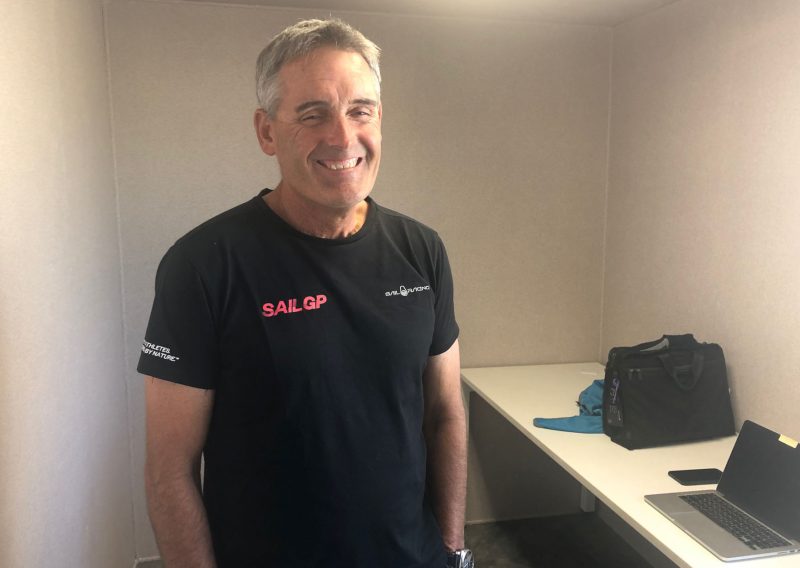
It’s clear these highly refined and further-evolved foiling cats will burn up the Bay at almost any wind speed. If conditions are right we could have a six-boat fleet racing at near 50 knots, and, when on opposite tacks, closing speeds of almost 100 knots. Other boats have exceeded 50 knots in straight-line speed runs, but fleet racing at these speeds is entirely new territory. Beyond sailing, the engineering and technical challenges of creating cutting-edge sailing machines are a continuing fascination for Coutts. “With 18 knots and reasonably flat water we should see 50 knots,” Coutts said. It should be flooding on the Cityfront during the noon to 2 p.m. race time.
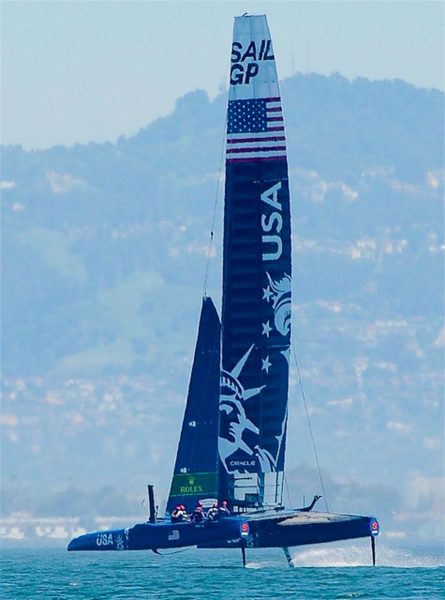
Beyond the technical, another aspect of SailGP Coutts enjoys is being in control of the entire event. Though he’s won the Cup five times, he lamented the incredible amount of time lost on the negotiations surrounding the America’s Cup Protocol defining rules for Defender and Challenger relating to the America’s Cup Deed of Gift. For SailGP, Coutts and his team define the rules and go sailing. After all those years racing for the ‘Oldest Trophy in Sports’ he’s now created the newest trophy in sports.
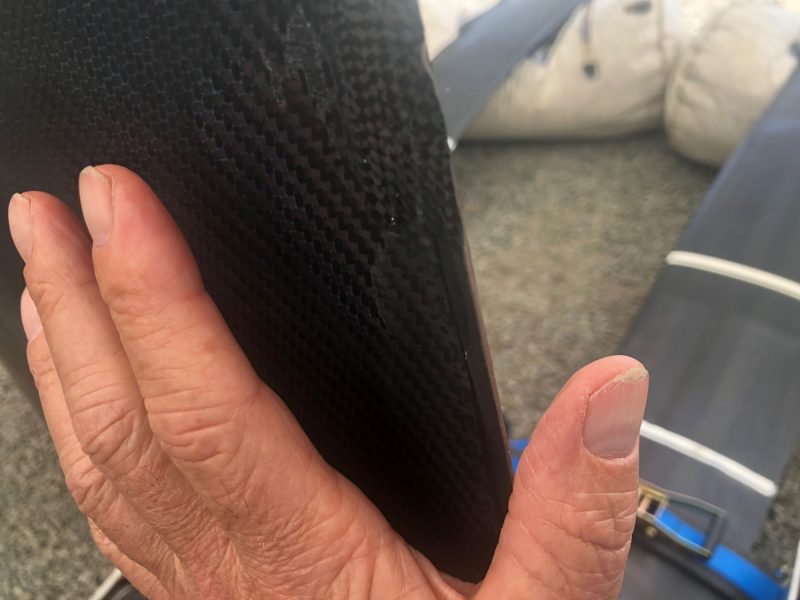
The other element discussed was the youth of the sailors. Unlike much of the sailing world, from the America’s Cup to Star champions, this league is dominated by sailors under 30. The American team is the youngest. Most of the sailors have experience in classes like 49ers, 29ers, Moths, catamarans and kiteboarding — somewhat relatable experience. But this is a quantum step up in speed and complexity. Additionally, the sailors have only spent perhaps 15 days on these boats practicing before and during the racing in Sydney. This means there’s still a big learning curve to climb to smoothly operate these waterborne fighter jets and an opportunity to continue the speed gains.
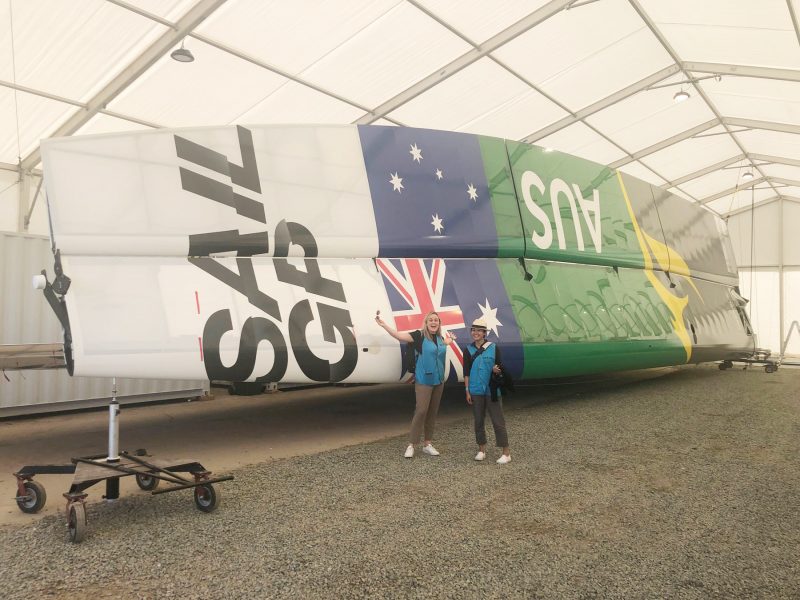
Coutts also alluded to plans to develop a youth path to this level of performance sailing. No matter how zippy the Nacra 15 or 17, it’s a big step up to a 50-knot, 50-ft foiling cat, so ideally there will be a step in between. We’ll look forward to seeing what emerges and, for those for whom fast is never fast enough, how they find a track to participate at this level.
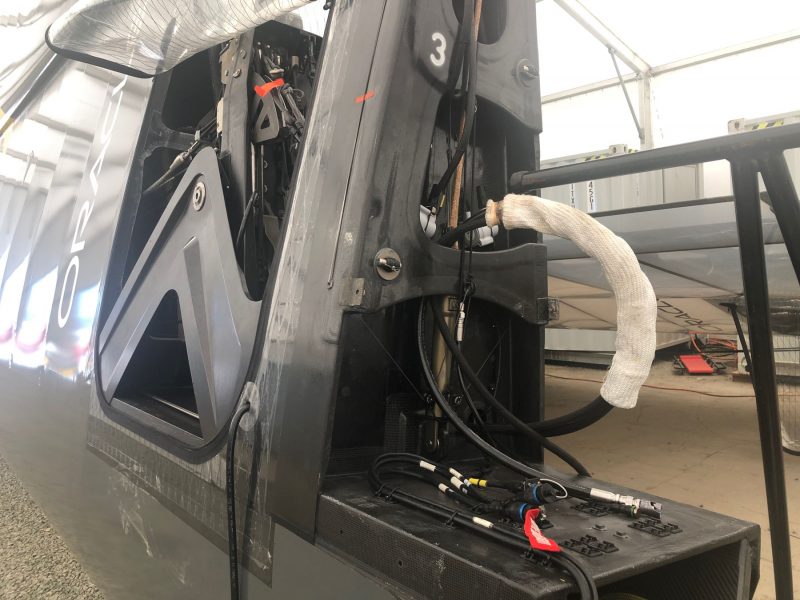
SailGP San Francisco is now just a week away. Spectators can buy tickets for ringside seats in the grandstands near the Golden Gate Yacht Club or on SailGP-organized spectator boats. You can get details on spectating opportunities here. At the recent Pacific Sail & Power Boat Show, Latitude 38 and Summer Sailstice also collected names to draw winners for tickets provided by SailGP. We have three very excited winners of the double passes to the May 4-5 event: Tammy Forrest, Piyush Arora and Michael Law are the three Bay Area sailors whose names were drawn from the hat (literally).
Piyush, who has been sailing regularly for only two years and is looking forward to one day racing his 31-ft Beneteau in the Pacific Cup, will no doubt be hoping to learn something from the professionals, though applying the lessons to recreational sailing may be challenging! “Watching the pros do it is always amazing,” says Arora. And Michael, a lifelong sailor originally from the Great Lakes region and now 30 years in the Bay Area, had the opportunity to see the boats close up during a tour of the race pits just 24 hours before learning of his win. “The tour was fantastic! Amazing technology and logistics.”
“We were crossing over from the City to San Rafael on Wednesday and caught a glimpse of GBR and one other boat heading back to the barn in Alameda just as the westerly was filling in,” writes reader John C. “Hope those folks can deal with 25 knots with a good ebb running with those finicky thoroughbreds — should be entertaining at the least.”
Since the 2013 America’s Cup the world of foiling has simply exploded. Seeing foiling kiteboarders is now the norm. The pioneering Moth is a very active foiling class worldwide. An early Bay Area pioneer was Russell Long, who started breaking world speed records as he developed the Greg Ketterman-created tri-foiler in the early ’90s. The Olympics will include the foiling Nacra 17 in Japan in 2020. Russell Coutts and SailGP competitors are on the outer limits of foiling competition. On May 4-5 we’ll see if the Bay serves up the right conditions and the ‘pilots’ of these carbon watercraft have the ‘the Right Stuff’ to push them over 50 knots plus hold it all together to make it to the podium.
If you’d like to get a preview of the main event, take note: “We plan to have F50s on the Bay every day between now and racing except on Sunday, April 28,” advises SailGP’s Christy Cahil. “The timing is generally in the noon to 4 p.m. window, and it can either be in the south area of the Bay near Oracle Park, or in our racecourse area between the Golden Gate Bridge and Alcatraz Island. The location is weather-dependent and determined day-of. April 30 and May 3 are practice race days; we’ll be in the City Front racecourse area during our race window (12:30-2 p.m.).”

